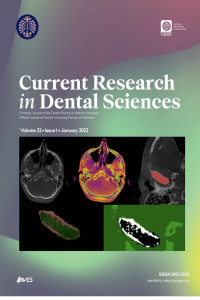KONİK IŞINLI BİLGİSAYARLI TOMOGRAFİ KULLANILARAK İNFRAORBİTAL KANAL VE SULKUSUN RETROSPEKTİF OLARAK İNCELENMESİ
Konik ışınlı bilgisayarlı tomografi, infraorbital kanal
___
- 1. Drake RL, Vogl W, Mitchell AWM. Gray's anatomy for students.Yıldırım M (çev. ed). Ankara. 2007; 8: 822-94.
- 2. Hu KS, Kwak J, Koh KS, Abe S, Fontaine C, Kim HJ. Topographic distribution area of the infraorbital nerve. Surg Radiol Anat 2007;29:383-8.
- 3. Mozsary PG, Middleton RA. Microsurgical reconstruction of the infraorbital nerves. J Oral Maxillofac Surg 1983;4:697-700.
- 4. Kazkayasi M, Ergin A, Ersoy M, Bengi O, Tekdemir I, Elhan A. Certain anatomical relations and the precise morphometry of the infraorbital foramen--canal and groove: an anatomical and cepha- lometric study. Laryngoscope 2001;111:609-14.
- 5. Miracle AC, Mukherji SK. Conebeam CT of the head and neck, part 2: clinical applications. Am J Neuroradiol 2009;30:1285-92.
- 6. Lascala CA, Panella J, Marques MM. Analysis of the accuracy of linear measurements obtained by cone beam computed tomography (CBCT-NewTom). Dentomaxillofac Radiol 2004;33:291-4.
- 7. Pinsky HM, Dyda S, Pinsky RW, Misch KA, Sarment DP. Accuracy of three-dimensional measurements using cone-beam CT. Dentomaxillofac Radiol 2006;35:410-6.
- 8. Suomalainen A, Vehmas T, Kortesniemi M, Robinson S, Peltola J. Accuracy of linear measurements using dental cone beam and conventional multislice computed tomography. Dentomaxillofac Radiol 2008;37:10-7.
- 9. Cattaneo PM, Bloch CB, Calmar D, Hjortshoj M, Melsen B. Comparison between conventional and cone beam computed tomography generated cephalograms. Am J Orthod Dentofacial Orthop 2008;134:798-802.
- 10. Aktan AM, Gungor E, Çiftçi ME, İsman Ö. Diş hekimliğinde konik ışınlı bilgisayarlı tomografi kullanımı. AÜ Diş Hek Fak Derg 2015; 25:71-6.
- 11. Orhan K, Mısırlı M, Aksoy S, Seki U, Hincal E, Örmeci T, Arslan. Morphometric analysis of the infraorbital foramen, canal and Groove using cone beam CT: considerations for creating artificial organs. Int J Artif Organs 2016; 39: 28-36.
- 12. Lee UY, Nam SH, Han SH, Choi KN, Kim TJ. Morphological characteristics of the infraorbital foramen and infraorbital canal using three-dimensional models. Surg Radiol Anat 2006;28:115-20.
- 13. Przygocka A, Szymanski J, Jakubczyk E, Jedrzejewski K, Topol M, Polguj M. Variations in the topography of the infraorbital canal/groove complex: a proposal for classification and its potential usefulness in orbital floor surgery. Folia Morphologica (Warsz) 2013;72:311-7.
- 14. Apinhasmit W, Chompoopong S, Methathrathip D, Sansuk R, Phetphunphiphat W. Supraorbital notch/foramen, ınfraorbital foramen and mental foramen in thais: anthropometric measurements and surgical relevance. J Med Assoc Thailand 2006;89:675-82.
- 15. Xu H, Guo Y, Lv D, Guo J, Liu W Qi, H,Qin J, Wang Z, Hou L, Zhang Y, Gao L, Li Y, Wang Y. Morphological structure of the infraorbital canal using three-dimensional reconstruction. J Craniofal Surg 2012;23:1166-8.
- 16. Hwang SH, Kim SW, Park CS, Cho JH, Kang JM. Morphometric analysis of the infraorbital groove, canal, and foramen on three-dimensional reconstruction of computed tomography scans. Surg Radiol Anat 2013;35:565-71.
- 17. Rahman M, Richter EO, Osawa S, Rhoton AL, Jr. Anatomic study of the infraorbital foramen for radiofrequency neurotomy of the infraorbital nerve. Neurosurgery 2009;64:423-38.
- 18. Caspersen LM, Christensen IJ, Kjaer I. Inclination of the infraorbital canal studied on dry skulls expresses the maxillary growth pattern: a new contribution to the understanding of change in inclination of ectopic canines during puberty. Acta Odontolog Scand 2009;67:341-5.
- 19. Ülgen PDM. Ortodonti, Anomaliler, Sefalometri, Etioloji, Büyüme ve Gelişim, Tanı. Yeditepe Üniv Yayınları 2000:213-308.
- Başlangıç: 1986
- Yayıncı: Atatürk Üniversitesi
SİNİR YARALANMALARI: NEDENLERİ, TEŞHİS VE TEDAVİLERİ
Sercan KÜÇÜKKURT, Hüseyin Can TÜKEL, Murat ÖZLE
TAM-ARK İMPLANT-DESTEKLİ MONOLİTİK ZİRKONYA SABİT DENTAL PROTEZLER: LİTERATÜR DERLEMESİ
Rukiye DURKAN, Gonca DESTE, Perihan OYAR
ANTERİOR DİASTEMA VAKALARININ DİREK KOMPOZİT RESTORASYONLA ESTETİK REHABİLİTASYONU: OLGU SUNUMU
Rabia BİLGİÇ, Nilgün AKGÜL, Taner TOPAL, Tuba KARAHAN
Saadettin DAĞISTAN, Özkan MİLOĞLU, Oğuzhan ALTUN, Esra KARAPINAR UMAR, Talat - EZMECİ
DENTAL DİJİTAL GÖRÜNTÜLEMEDE ÜÇÜNCÜ BOYUT
DİJİTAL DENTAL FOTOĞRAFÇILIK-II
Funda BAYINDIR, Berkman ALBAYRAK
ÇOCUK DİŞ HEKİMLİĞİNDE KULLANILAN KAVİTE DEZENFEKSİYON YÖNTEMLERİ
